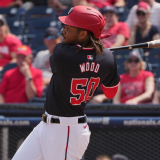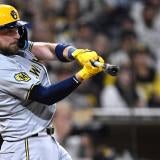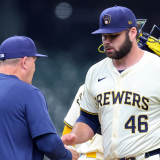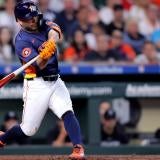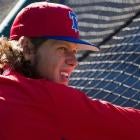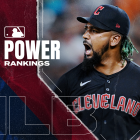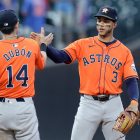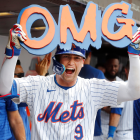With the regular season concluding, we've decided to take a look at each team's future -- not by using a crystal ball or other psychic abilities, but by evaluating their farm systems. Below you'll find our ranking of the top five prospects in the organization -- sorted by perceived future potential -- as well as five other players who fit various categories. Those categories are:
2020 contributor: A player who is likely to play a role for the big-league team next season.
Analyst's pick: A player who is a strong statistical performer and/or whose underlying measures are better than the scouting reports suggest.
Riser: A player on the way up.
Faller: A player on the way down.
One to watch: An interesting player to keep in mind (for whatever reason).
These rankings were compiled after talking with various industry sources about the systems (and players) in question. It should be acknowledged that this process is more art than science, and that there are limits to ordinal rankings. Still, it's an intuitive system, and our hope is that the write-ups will answer any questions by providing additional context and analysis of each player -- such as their pluses and minuses; the risk factors involved; and their estimated arrival date.
One last word on eligibility: we're following MLB's rookie guidelines by disqualifying any player with more than 130 big-league at-bats or 50 innings pitched.
Shaky drafts and trades have left the Phillies without a great farm system. But there's still some talent on its way that could help.
1. Spencer Howard, RHP
The Phillies' second-round pick in 2018, Spencer Howard may have reached the majors this season were it not for shoulder trouble that cost him two months of the summer.
Howard ended up getting to Double-A for his final six starts. In those outings, he averaged five innings per pop while permitting 20 hits, eight earned runs, and nine walks. He struck out 38 batters and limited the opposition to a .180/.254/.288 line against. In other words, he's going to reach the majors sometime in 2020 -- potentially sometime early on, if his health allows.
Howard has the chance to be an above-average big-league starter thanks to a well-rounded arsenal that includes a high-quality fastball and slider, as well as a changeup and curve. He's yet to top 130 innings, so it'll be interesting to see how the Phillies manage his workload.
2. Alec Bohm, 3B/1B
When Alec Bohm was drafted third overall in 2018, he tied Braden Looper for the distinction of being the third-highest selected player from Wichita State University. (Joe Carter and Darren Dreifort each went second in their draft years.) Believe it or not, the most successful Shocker has been Casey Blake, who accumulated 25 Wins Above Replacement for his career.
Blake played in parts of 13 big-league seasons, seeing most of his action at third base with some corner outfield and first base mixed in. It's unclear if Bohm will follow in Blake's cleatprints, but it's at minimum it's possible he ends up moving off third base over the next couple years. The Phillies tasked him with playing 24 games at first base during the minor-league season, and they've continued to crosstrain him there as part of his stint in the Arizona Fall League.
Wherever Bohm ends up, this season seemed like a step in the right direction at the plate. In the past he prioritized contact to the point where he didn't seem to make the most of his large frame (he's listed at 6-foot-5 and more than 220 pounds). For reference, he went without a homer in his first 158 professional plate appearances. He showed far more power in 2019, homering 21 times and posting a .213 ISO. That's a promising sign -- and one accompanied by a favorable shift in batted-ball tendencies.
If Bohm keeps it up, he could be batting in the middle of the Phillies' order -- and playing some position -- as soon as late next season.
3. Bryson Stott, SS
Bryson Stott might've been pushed to another position already had he played a couple decades ago. That's because Stott is listed at 6-foot-3, which is on the taller side for shortstop -- or was, anyway. There have been 115 individual seasons where a player at least 75 inches tall tallied 300-plus plate appearances and manned shortstop 75 percent (or more) of the time -- 44 of those have happened since 2008.
The Phillies figure to give Stott a fair chance to stick at the six after selecting him with their 2019 first-round pick.
Stotts earned their interest by hitting .356/.486/.599 with 32 extra-base hits and 16 more walks than strikeouts at UNLV. He has a long swing and there's a chance his hit tool plays a little worse than expected if he's unable to make adjustments against better pitching.
Still, the upside here is a two-way shortstop. That's worth the gamble.
4. Francisco Morales, RHP
Francisco Morales won't turn 20 until the end of October, but he has a lot working in his favor -- including one of the highest strikeout rates in A-ball, behind names like Grayson Rodriguez, Seth Corry, and Luis Gil.
Morales has a big frame (he's listed at 6-foot-4, 185 pounds already) and shows the makings of a strong two-pitch arsenal in his fastball and slider. He needs to work on his command and his changeup -- and there's certainly a chance he ends up in the bullpen -- but, again, he's 19.
Put a star next to Morales' name. He's one to watch.
5. Adonis Medina, RHP
At some point, potential can't carry the day.
Adonis Medina shows the raw stuff to be an above-average big-league starter. But inconsistency has plagued him to the point where he fanned seven batters per nine during his first spin at Double-A. For context, that was the worst rate among the 11 pitchers on the team's staff with 50-plus frames on the season -- and only one other finished below eight.
A theory out there is that Medina lacks deception -- which can present itself in a number of ways, ranging from showing the ball to the hitter too much to tipping with varied release points. Whatever the case, Medina will need a better 2020 if he's to remain on the list.
2020 contributor: Enyel De Los Santos, RHP
Originally acquired in exchange for Freddy Galvis in 2017, Enyel De Los Santos made his first big-league appearances in 2018 and returned to the scene for five more in 2019. He has a good fastball-changeup combination, but his breaking balls and delivery are substandard and will likely limit him to a career in relief. It's not all bad for De Los Santos: he's likely to make more big-league appearances in 2020.
Analyst's pick: Simon Muzziotti, OF
Ardent fans might recall Simon Muzziotti as one of the prospects the Red Sox had to relinquish as punishment for circumnavigating the international free-agent signing rules. He ended up with the Phillies and he just completed the best statistical season of his career, hitting .287/.337/.372 with 21 steals (albeit at a poor success rate). Muzziotti can really run and should profile as above-average in center field. At the plate, he's prone to putting the ball in play. The lack of power is concerning in the sense that his hit tool could play below expectations if he's unable to keep pitchers honest. For now, he's a 20-year-old with plenty to dream on.
Riser: Damon Jones, LHP
An 18th-round pick in the 2017 draft, Damon Jones made the most of his second full professional season by pitching across three levels. Jones is a tall lefty with a drop-and-drive delivery and a fastball-slider pairing that grades as at least average. The Phillies haven't experimented with him in the bullpen yet, but there's a chance he lands (and excels) there as soon as the 2020 season. Do note that he'll turn 26 next September.
Faller: JoJo Romero, LHP
JoJo Romero opened in Triple-A but was demoted after a seven-start stretch that saw him permit 44 hits, 30 earned runs, and nearly as many walks (19) as strikeouts (22) in 28 innings. He returned to Triple-A late in the year, and fared better -- just not by a ton, as he yielded 24 hits and again nearly as many walks (16) as strikeouts (18) in 25 frames. Romero at his best has three average or better pitches and looks like at least a back-end type. It's easy to dismiss his struggles as a product of the ball, but that doesn't help his big-league chances, now does it?
One to watch: Luis Garcia, SS
Not to be confused with the Nationals' shortstop prospect of the same name, this Luis Garcia is a 19-year-old switch-hitter who may develop four tools that are at least average. Garcia had a rough season in the South Atlantic League, hitting just .186/.261/.255 with three times as many strikeouts as walks and just one fewer caught stealings (eight) than stolen bases (nine). Hey, sometimes progress isn't linear.



